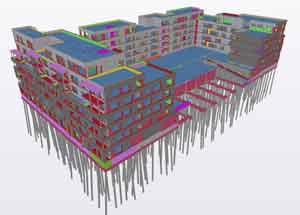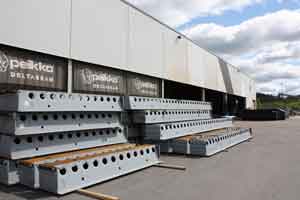Precast and other modern technologies, such as Constructible BIM, will revolutionise India’s construction industry, and allow it to be an even more powerful engine of India’s economic growth, believes
Paul Wallett.
 Paul Wallett,
Paul Wallett, Regional Director, Trimble Solutions, India and Middle East.
Pull Quote to be used with Author’s image/brief:
Demanding clients and factors like rising labour and input costs, besides an increased emphasis on quality, have all forced a growing number of developers and construction companies in the country to embrace precast tech.
The construction sector in India contributes 11 per cent to the national GDP, which is quite comparable to contribution from the agriculture sector, which has been a huge contributor to India’s GDP for a few decades now. Construction is also one of the largest sources of employment, providing livelihood to nearly 33 million people in India.
Given its huge economic footprint, it is absolutely vital for Indian construction industry to continue to grow at a steady pace for the country’s continued economic well-being. And, modern construction processes and technologies can play an important role in driving the industry’s growth in the years to come.
 What is precast construction?
What is precast construction?
An important construction technology that is fast gaining popularity is precast construction, which has emerged as a preferred alternative to the conventional concrete-based construction practices in recent times. Simply put, precast concrete is a form of construction where concrete is cast in a reusable mould or ‘form’, which is then cured in a controlled environment, transported to the construction site and lifted into place to construct a building.
This technology is very similar to construction of a vehicle where parts of the vehicle are manufactured in different factories and the final product is assembled in a given factory. Using Precast technology, a majority of structural components of buildings (such as slabs, columns, beams, walls, etc.) are standardized and produced in plants in a location away from the building site, and then transported to the site for assembly.
These components are manufactured by industrial methods based on mass production, and this process enables construction of a higher number of buildings in a relatively shorter time, and total cost of ownership is also lower.
Why precast construction?
Whether it is industrial project or a residential building, precast concrete methodology is now widely seen as an economic and eco-friendly option that delivers high-quality and resilient structures in shortened time. In fact, given that there is now a universal emphasis on cutting down construction timelines but without sacrificing the desired finished quality, and, of course, the need to optimize labour costs and reduce environmental pollution, the use of precast technology is seen as a panacea.
Apart from clear business and economic benefits, rapid urbanisation is another reason why precast is finding favour within the construction industry in India. With rapid migration to urban areas, all major Indian cities, including Mumbai and Delhi, are finding themselves well-short of adequate housing inventory for their residents.
Many countries, such as Singapore, Malaysia and Indonesia, which have faced similar problems with urbanization in the past have successfully built adequate housing infrastructure using precast concrete. These global best practices in construction are now being employed for developing high-quality affordable housing infrastructure in Indian cities.
So, why is it that global construction industry favours precast so much? Compared to conventional cast-in-place (CIP) concrete systems, precast concrete is suitable for developing both conventional and modular structures of high quality. Precast is also extremely safe, for the technology has passed rigorous safety standards around the world for seismic and structural testing and fire safety.

It is also environment-friendly, though the biggest benefit which gladdens the industry’s heart is the reduction in overall construction costs by as much as 15 per cent. This factor alone should make Precast technology the construction method of choice for India’s ‘Housing for All’ initiative.
The cost savings are borne out of two unique and exclusive features of Precast tech:
- Improved speed of delivery, and
- Ease of installation.
Both these features contribute directly to lower Total Cost of Ownership (TCO) and are unmatched by CIP or cast-in-situ concrete.

To certain sections of the industry, the initial investment in Precast appears higher as opposed to CIP concrete, but there is a significant reduction in overall expenditure through time saved, wastage avoided and consistent quality delivered with the finished product. Further savings in reinforcement and concrete are also possible due to the accurate production of precast concrete elements and the utilization of slim building elements.
These material savings too decrease the overall production costs of precast concrete elements. In summary, the benefits of adopting Precast construction far outweighs the initial challenges of changing existing practices.
Better quality, an important differentiator for Precast concrete, is a given when it is produced in certified plants with controlled batch proportions and under uniform conditions. Buildings or structures constructed using Precast Concrete are more robust than traditional brick and mortar constructions.
As actual ‘construction’ happens in a controlled factory environment, issues caused by environmental factors like bad weather are also eliminated. Because the precast wall panels extend into a building’s footings, these buildings are safer too and cope better with fires or cases of water damage and accidental impact.
Precast construction in India
It is therefore not surprising that the demand for precast technology within the Indian construction community is gaining at a fast clip. This is in stark contrast from the scenario barely a decade ago, when India’s construction industry was yet to wake up to modern and innovative construction technologies. And precast concrete, despite being widely used around the globe, was relatively unknown.
The fledgling precast fabrication industry has had a big role to play in driving this growth and a couple of big Pune-based names in this industry guided other stakeholders to make a smooth transition towards precast concrete. In 2015, Tekla, a global industry leader in construction software, joined hands with Precast India Infrastructure Pvt. Ltd. (PIIPL) to hasten the transition towards more precast construction, a significantly more advanced building technology. Today, a number of leading construction companies use Tekla’s renowned software solutions to construct prefab buildings in India.
Demanding clients and factors like rising labour and input costs, besides an increased emphasis on quality, have all forced a growing number of developers and construction companies in the country to embrace precast tech. In Maharashtra, MHADA already builds affordable housing using precast, as do a few other leading construction firms.
Experts say precast can also be a major boost to India’s infrastructure push and can play a major role in realizing India’s dream of affordable housing for every citizen. Trimble is convinced that use of precast and other modern technologies, such as Constructible BIM, will open new growth avenues for India’s construction industry, and allow it to be an even more powerful engine of India’s economic growth.